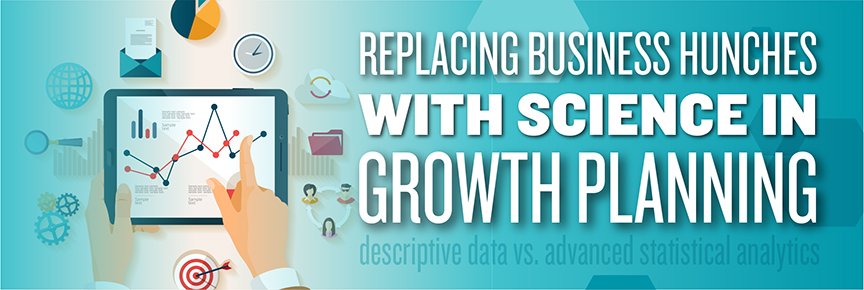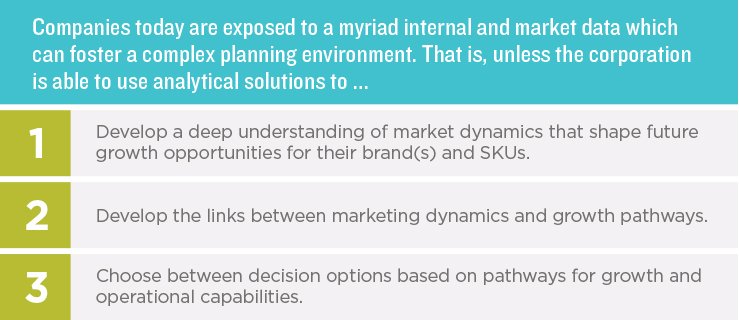Growth planning often requires making difficult compromises. Striking a balance between addressing current business challenges, beliefs about the future and expectations from shareowners, are examples of such compromises. The final growth plan explains how company and product performance of the company and its products will improve based on a set of realistic assumptions and planned actions. Most companies recognize that such plans work best when informed by advanced analytics rather than subjective ideas supported by descriptive data. They acknowledge that today’s marketplace is so complex that advanced statistical algorithms combined with ‘big data’ play a critical role in developing and testing growth decisions. Why then are so many companies dependent upon descriptive data trends such as market share data and historic sales when making strategic growth decisions?
All companies have far more data than they can effectively utilize in the planning process. In fact, it is estimated that 99.5% of all data a company collects will never be used. For more detailed information on data usage check out “Big Data: 20 Mind-Boggling Facts Everyone Must Read,” Forbes (September, 2015). Leading companies have systems in place to process large amounts of strategic planning data, but very few actually formulate what-if hypotheses when exploring opportunities and defining strategies. Even fewer companies test the hypotheses they have developed. Under time constraints, complex planning processes and/or limited budgets, the default option of relying on business hunches to form strategic decisions prevail. Without proper testing, hypotheses, past experiences, reasoning and gut feelings all too easily become “facts.”
Many commercial leaders find it difficult to accept advanced analytics, typically perceiving it as a ‘black box of statistical acrobatics.’ They question its validity in making business decisions, and therefore, tend to favor descriptive data which lets the commercial leader fill in the blanks with his experience and connect the dots with his intellectual ability. By using advanced analytics, we leave this ‘interpretation’ up to statistical algorithms, reducing the level of transparency and making many commercial leaders uncomfortable. This is arguably an important negative aspect, as only analytic outputs that confirm current beliefs may be deemed ‘good analytics’. Results that challenge current ideas tend to be met with skepticism and rejection. The willingness to accept marketing as a scientific discipline among business leaders is still limited.
Consequently, advanced statistical analysis is considered a nice-to-have, or merely a complement to descriptive analyses and business hunches. This reduces the quality of business planning efforts and of growth decisions embedded into the plan. For example, descriptive analysis has no room for testing alternative decision options; it remains focused on the past and says nothing about the underlying response dynamics of the marketplace. Former CEO of Procter & Gamble A.G. Lafley points to this challenge in the celebrated 2012 Harvard Business Review article “Bringing Science to the Art of Strategy”. While using a massive amount of descriptive analyses as support for business planning may leave the impression of a scientific approach to defining growth strategies. However, this is merely an illusion since a scientific approach requires definition and testing of hypotheses. With planning based solely on descriptive data, the focus remains on present growth challenges and the business plan as opposed to addressing future opportunities and risks.
Why is this important? We believe strategic planning is among the most core pursuits of any company. A strong business plan can have a transformational impact on company performance and its ability to respond effectively to marketplace changes.
These days, many companies struggle to navigate and leverage the extensive access to ‘big data’ while remaining focused on core business decisions that drive growth. Only by taking advantage of advanced statistical modeling can a company proclaim a truly scientific approach to business planning. The good news is that analytics platforms are now available for companies ready to transform their approach to growth planning.
— Vegard Søhus, Partner at Middlegame Marketing Sciences
Middlegame is the only ROMI consultancy of its kind that offers a holistic view of the implications of resource allocation and investment in the marketplace. Our approach to scenario-planning differs from other marketing analytics providers by addressing the anticipated outcome for every SKU (your portfolio and your competitors) in every channel. Similar to the pieces in chess, each stakeholder can now evaluate the trade-offs of potential choices and collectively apply them to create win-win results.



